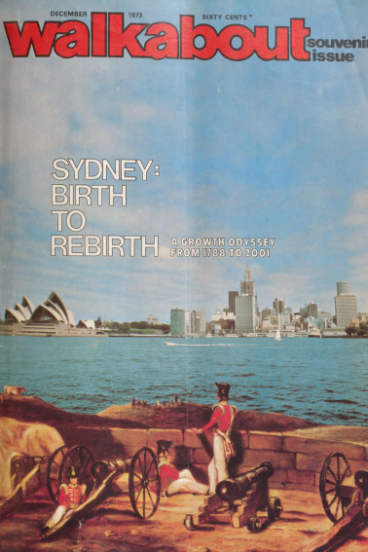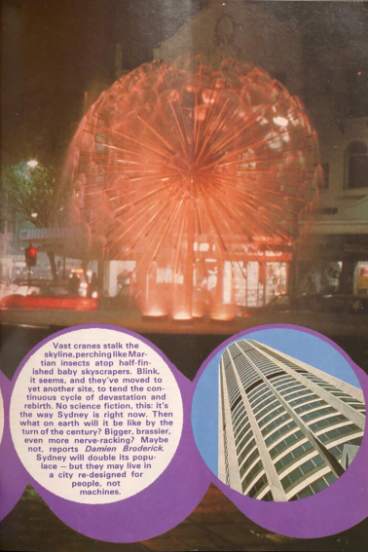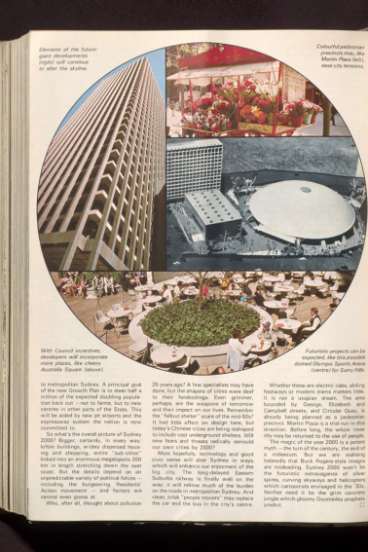

The cover of Walkabout magazine in December 1973.Credit:National Library
“It was the kind of magazine people read in doctors' surgeries, train stations and when they went to the dentist,” Ms Johnston said. “It had fabulous photography – beautiful black and white photography by some of Australia’s leading photographers – and [words by] some of the mid-century’s most interesting writers.”
Most issues looked at Australia beyond the big cities and the wider South Pacific region – from cattle droving in central Queensland to the independence movement in Papua New Guinea.
But the December 1973 issue was dedicated to Sydney, including an article by Damien Broderick about what the city would be like in the year 2000. Many of the predictions have come true or are on track to do so.
The article forecast that Sydney would double its population to 5.5 million by 2000 but expressed hope it would become “a city redesigned for people, not machines”. Population figures released by the Australian Bureau of Statistics in November show Sydney’s population was 5.1 million in 2017 and is expected to grow to between 6 million and 6.4 million by 2027.

The concerns of Sydneysiders about their city in 1973 were similar to now.Credit:Walkabout via National Library
City planners in the early 1970s envisaged 300,000 to 400,000 workers in the city centre by 2000, but with “many amenities already strained” at 250,000, the lower end was considered most plausible. In 2018 there are nearly 500,000 workers in the City of Sydney, admittedly in enlarged boundaries that include neighbourhoods on the city fringe.
Urban planning expert George Clarke warned in 1973 that Sydney should not become a “playground” for real estate speculators, nor mere collections of unrelated sites on which to display the “virtuosity of architects, engineers and developers in producing elegant and astonishing monuments”.
The article was published two months after the opening of the Sydney Opera House. Other recent or upcoming constructions included Centrepoint Tower, the AMP Centre and St Martin’s Towers. "Cheery" Australia Square was described as an “outstanding example” of how developers could voluntarily provide civic use because of the plaza and shops at the base of the building.
Meanwhile there was speculation about what futuristic building projects might look like, including an artist's impression of a possible domed Olympic Sports Arena in Surry Hills. Sydney did host the Olympics in 2000 but the main Olympic site was further west at Homebush Bay.
Back then the eastern suburbs railway was under construction and planners thought “clean, brisk people movers” might replace the car and the bus in the city centre, with Martin Place, which they called Martin Plaza, a harbinger of the future pedestrian utopia. In 2018 the state government is constructing a light rail route down George Street to replace buses and cars in some sections.

Pictures of recent or imagined development in Sydney, including a possible Olympic dome in Surry Hills.Credit:Walkabout via National Library
Telecommuting using a “TV telephone” or holography was regarded as a pipedream, because organisational psychologists believe that “people like to conduct their transactions in the flesh”. The technology has improved but the same debate is still ongoing.
A government strategic plan for Sydney from the 1970s specifically referred to a need to protect the “intensive activity” of Kings Cross, with “tourists and suburban visitors, residents, strolling people – watchers, ‘bikies’, prostitutes and strip-joint spruikers, the young and old” mingling most nights. In an echo of the Keep Sydney Open campaign and recent talk about the night time economy, the urban planners of the time considered a red-light district to be as much a part of a vital metropolis as the prestige high-rise and cathedrals.
The article quotes John Olsen, already a renowned artist at the time, describing his horror of the over-developed city he considered the Sydney of 1973 to be.
Loading
"I only know how I stiffen my sinews and gird the loins, and how my pulse-rate accelerates when I am forced to make one of my infrequent visits to the City,” Olsen said. “Tensions flash through my mind – "where shall I park?" – and when I arrive, through all the unspeakable traffic hassle, I know I am small and insignificant in the vast, sunless, glass valleys."
Olsen was invited to reflect on his comments 45 years later but did not respond by press time.
Caitlin Fitzsimmons edits the Money section for SMH and The Age and writes columns about life, money and work. She is based in our Sydney newsroom.









 Add Category
Add Category